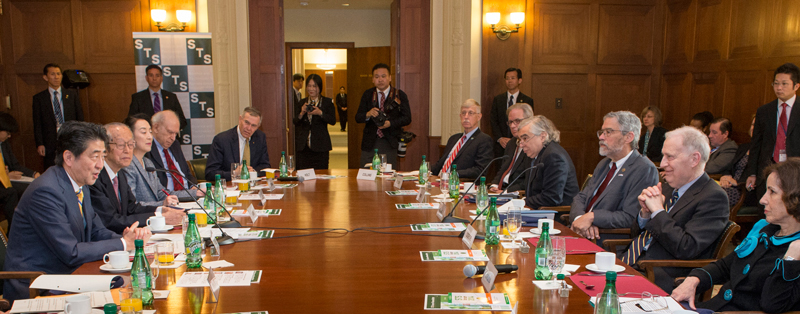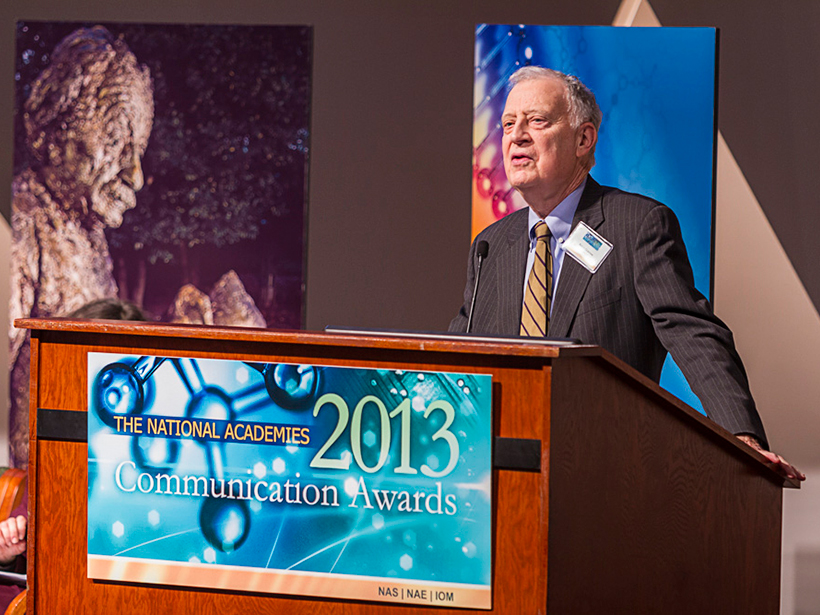Oceanographer Marcia McNutt, who on 1 July assumed the presidency of the U.S. National Academy of Sciences (NAS), will face many challenges, according to her predecessor, Ralph Cicerone. However, dismissive or unwelcoming treatment from the science community because she is a woman—the first woman to lead NAS—won’t be among the challenges she will face, Cicerone told Eos recently in a wide-ranging conversation about science and society.
Cicerone, an atmospheric scientist, stepped down 30 June after serving two terms at the academy’s helm. In the first article, published last week, of a two-part series, Cicerone discussed climate change and political polarization. In this article, he talks in general about women and underrepresented minorities in science, the Obama administration, and McNutt, who not only became the first woman to lead the academy last week but also its second geoscientist in a row in that role. The academy, established by Congress in 1863, is a private nonprofit society that provides independent, objective advice to the nation on science and technology-related issues.
Gender a Plus for New Academy President
Cicerone said McNutt likely will face many of the same challenges that confronted him, including attacks on the scientific evidence of human-induced climate change and a segment of the U.S. population that resents authority, particularly federal authority in Washington, D. C. However, “I don’t think there is any resistance amongst the academy membership or larger forces to say, ‘Gee, we don’t want to deal with a woman.’ I think it is going to be the opposite,” he said. “I’ve been in places where I’ve had to represent American science one way or the other and I could just sense that they want a woman.”
“Putting a face on American science that’s female and younger is going to be really great.”
Cicerone, who is 73, added that “they want someone younger. After all, I’ve gotten old in this job. So I think putting a face on American science that’s female and younger is going to be really great.” McNutt is 64.
“Marcia will be great because she’s pretty energetic. I don’t think she’s going to have any disadvantages. I could be wrong. There’s still some holdovers who will somehow not give full credence to a woman, but I think it will be fine.”
The academy’s nominating committee was “not bound and determined to find a woman [to lead NAS]. They were not bound and determined to address climate change. That’s not it at all,” he said, stating that the committee likely sought someone with experience dealing with the federal government, an aptitude for handling controversies, and a commitment to the scientific method. “Broad issues like that, I think, were what the nominating committee used in a very extensive search,” he said. “Maybe the fact that Marcia has been so active in scientific publication, scientific integrity, things like that where she’s really distinguished herself, maybe that, I’m just guessing, maybe that completely overwhelmed any other consideration.”
Academy Membership Trends
Cicerone said the academy has been doing better in bringing more women into the institution. In 2005 when he took the helm, women composed 9.5% of academy members (187 of 2062 members); by 2016 that number increased to 15.1% (354 out of 2351 members). This year, women composed 28.6% (24 out of 84) newly elected academy members. “It’s just happening because there are a lot of overqualified women coming through the ranks” who are among the best people in their fields, Cicerone said. “Bingo. It wasn’t that hard.”
However, Cicerone expressed disappointment in the progress made to increase the number of academy members from underrepresented minorities. “We have not done a good job finding new members in minority communities,” he said. “There are some marvelous success stories but there aren’t enough of them. We’ve made only minor improvements there in our membership.”
Maintaining the Quality of Academy Reports
Cicerone, who also served as chair of the National Research Council (NRC), an arm of NAS, said that “job number one” for him was maintaining the quality and suitability of the approximately 200 NRC reports issued annually although federal reimbursements that help pay for those reports have diminished. As an example of the NRC reports produced during Cicerone’s watch, the body issued last year its first-ever decadal survey of ocean science, entitled Sea Change: 2015–2025 Decadal Survey of Ocean Sciences. Other recent examples include a 2016 report about extreme weather and climate change and a 2015 report on science education standards.
“Financially, things have been tough,” Cicerone told Eos. The recently released 2015 NAS treasurer’s report states that over the past 5 years the annual federal funding to reimburse project costs, which include scientific reports, dropped by about $71 million, or 25%, from approximately $278 to $207 million. During that same period, funding from private and other sources increased $20 million, from $52 to $72 million, making up for some of the decline.

International Scientific Relations
NAS maintains relations with science academies around the world and often collaborates with them, as it did in issuing joint statements with other academies of the G7 (Group of 7) countries prior to the May 2016 G7 meeting. Despite current tensions between the United States and Russia largely due to the latter’s 2014 annexation of part of the Ukraine, science diplomacy between the two nations continues, Cicerone noted. However, informal relationships between U.S. and Russian science academies have become more difficult. That’s partly because the Russian science academy has come increasingly under government control, Cicerone said. “Their land, their headquarters [are] being taken away by the government. It’s not clear yet whether their elections are still under their control. So that’s sad.”
Cicerone stressed the importance of good relations among academies. “You never know when it’s going to help,” he said, mentioning as an example that private meetings between Soviet and American physicists helped with strategic arms limitation talks between former USSR president Mikhail Gorbachev and former U.S. president Ronald Reagan in the 1980s.
U.S. Science and Policy
Speaking further with Eos on the U.S. political climate that has caused him much concern (see the first article of this series), Cicerone also lauded some Republican and Democratic politicians for their support for science—particularly President Barack Obama. Cicerone said many members of the President’s Council of Advisors on Science and Technology (PCAST) have told him that Obama’s interest in science is what keeps them going. Obama is “really interested. Now, that’s separate from politics,” Cicerone said. “I don’t mean this to be a political statement. But from a science point of view, the demonstrated interest of the president in science and technology issues across the board—health, engineering, you name it—that keeps PCAST going and it certainly keeps [White House science adviser] John Holdren going.”
Holdren “tries to bring science into decision making in the government where it has been neglected before. And it’s frustrating. I think what keeps him going is a commitment to the cause as well as the interest of the president.”
Obama’s appointment of respected scientists “is a way to take advantage of science in a democracy.”
Cicerone said that Obama’s appointment of respected and knowledgeable scientists to key administration positions paid off in many ways, including participation by some of them in helping to come up with solutions to the 2010 Deepwater Horizon oil spill in the Gulf of Mexico. For instance, Steven Chu, who was U.S. secretary of energy from 2009 to 2013, coled a science team that developed analyses and plans to control the flow of oil from the well and provided a determination of the leak rate. “Steve brought things to the government which had never been seen before, like gamma ray imaging to see whether the [shutoff] valves were functioning or not,” Cicerone said.
Appointing top scientists “is a way to take advantage of science in a democracy,” he said, adding, “We may not have the answers today, but there are ways to find out more.”
—Randy Showstack, Staff Writer
Citation:
Showstack, R. (2016), Former academy head predicts few obstacles for female successor, Eos, 97, https://doi.org/10.1029/2016EO055451. Published on 06 July 2016.
Text © 2016. The authors. CC BY-NC-ND 3.0
Except where otherwise noted, images are subject to copyright. Any reuse without express permission from the copyright owner is prohibited.

